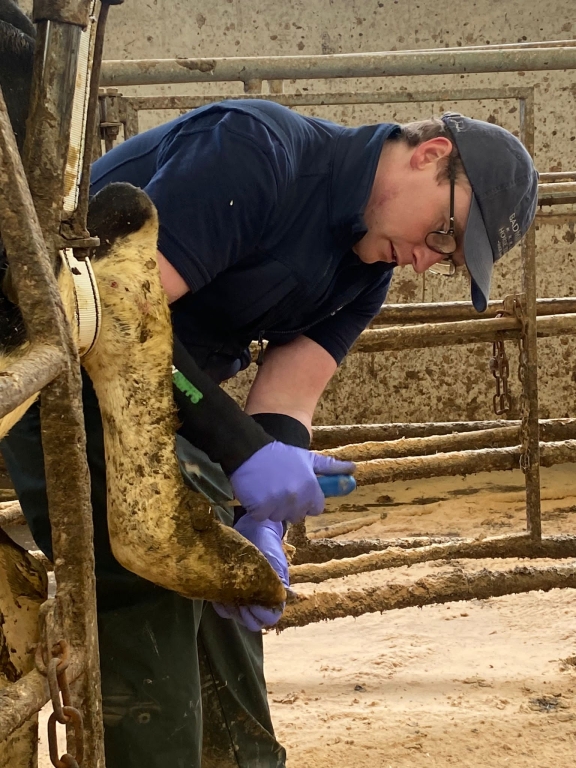
New Study Demonstrates The Benefits Of Routine NSAID Use In Dairy Heifers At Calving To Reduce Lameness
A recent study1 has identified the benefits of using NSAIDs routinely in heifers at first and subsequent calvings and, in conjunction with conventional best practice of a therapeutic trim and a hoof block, every time a dairy heifer is identified as lame.
Lameness is one of the most significant problems facing the dairy industry worldwide, having a major impact on cattle welfare, health and production, leading to substantial economic losses2. Within the UK, the mean herd lameness prevalence was recently found to be 30.1%3. Claw horn lesions (CHL) are one of the most common causes of lameness in dairy cows4 and recent veterinary advances have identified the role of inflammation in disease aetiopathogenesis5.
During the study, 528 dairy heifers were recruited for a 34-month randomised controlled trial to investigate the effects of routine treatment with a NSAID at calving and during treatment for lameness, on the future probability of lameness and culling. The cows were exposed to normal farm conditions and were split into four groups:
Group 1 – cows received a therapeutic trim and a hoof block on the sound claw (if deemed necessary) every time they were treated for lameness
Group 2 – animals received the same treatment as group 1, with the addition of a 3-day course of a NSAID (single dose daily) every time they were treated for lameness
Group 3 – cows received the same treatment as group 2, with the addition of a 3-day course of a NSAID (single dose daily) starting 24 to 36 hours after each calving
Group 4 – animals received a 3-day course of a NSAID (single dose daily) every time they were identified as lame.
Cows were monitored for the duration of the study and probability of lameness was assessed by a lameness outcome score collected every 14 days. Data on culling was also extracted from farm records. 438 animals were included in the final analysis which revealed that treating a cohort of cows following the group threeprotocol led to an absolute reduction in lameness of approximately 10% and severe lameness of 3%, compared with animals treated in accordance with conventional best practice (group one).
James Wilson BSc(Hons) PhD, foot health consultant and lead researcher on the trial, comments: “It appears that through giving heifers a NSAID at critical time points, we have imparted a substantial, long-lasting benefit to them. When freshly calved heifers enter the herd for the first time, we understand that they are (typically) naïve to lameness and have good hoof health. By utilising NSAIDs strategically, we believe that we have preserved the functionality of the foot, thereby reducing the risk of lameness. This is a highly efficacious, cost-effective means of managing lameness on farm.”
There is a wide range of NSAIDs available with different properties including duration of action and withdrawal times. In dairy cows, it is advisable to consider using a zero milk-withhold NSAID which is fully licensed to treat lameness in cattle to avoid any need to discard milk, however no NSAID is currently licensed in the UK to treat the pain associated with calving, so careful advice should be given to farmers based on the farm type and production methods.
For further information on the study visit https://doi.org/10.3168/jds.2021-21329.
References
- Wilson JP, Green MJ, Randall LV et al. Effects of routine treatment with nonsteroidal anti-inflammatory drugs at calving and when lame on the future probability of lameness and culling in dairy cows: a randomised controlled trial. J Dairy Sci. 2022; 105(7):6041-6054. https://doi.org/10.3168/jds.2021-21329
- Willshire, J. and Bell, N.J., 2009. An economic review of cattle lameness. Cattle Practice 17(2):136-141.
- Randall L. et al 2019. Lameness prevalence in a random sample of UK dairy herds. The Veterinary Record, 184(11): 350.
- Leach, K.A., D.A. Tisdall, N.J. Bell, D.C.J. Main, and L.E. Green. 2012. The effects of early treatment for hindlimb lameness in dairy cows on four commercial UK farms. Vet. J.. doi:10.1016/j.tvjl.2012.06.043.
- Newsome, R., M.J. Green, N.J. Bell, M.G.G. Chagunda, C.S. Mason, C.S. Rutland, C.J. Sturrock, H.R. Whay, and J.N. Huxley. 2016. Linking bone development on the caudal aspect of the distal phalanx with lameness during life. J. Dairy Sci.. doi:10.3168/jds.2015-10202.

 2 years ago
2 years ago  950 views
950 views

 3 days ago
3 days ago